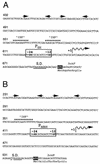Transcriptional regulation of Alcaligenes eutrophus hydrogenase genes
- PMID: 9620971
- PMCID: PMC107822
- DOI: 10.1128/JB.180.12.3197-3204.1998
Transcriptional regulation of Alcaligenes eutrophus hydrogenase genes
Abstract
Alcaligenes eutrophus H16 produces a soluble hydrogenase (SH) and a membrane-bound hydrogenase (MBH) which catalyze the oxidation of H2, supplying the organism with energy for autotrophic growth. The promoters of the structural genes for the SH and the MBH, PSH and PMBH, respectively, were identified by means of the primer extension technique. Both promoters were active in vivo under hydrogenase-derepressing conditions but directed only low levels of transcription under condition which repressed hydrogenase synthesis. The cellular pools of SH and MBH transcripts under the different growth conditions correlated with the activities of the respective promoters. Also, an immediate and drastic increase in transcript pool levels occurred upon derepression of the hydrogenase system. Both promoters were dependent on the minor sigma factor sigma 54 and on the hydrogenase regulator HoxA in vivo. PSH was stronger than PMBH under both heterotrophic and autotrophic growth conditions. The two promoters were induced at approximately the same rates upon derepression of the hydrogenase system in diauxic cultures. The response regulator HoxA mediated low-level activation of PSH and PMBH in a heterologous system.
Figures






References
-
- Amann E, Ochs B, Abel K-J. Tightly regulated tac promoter vectors useful for the expression of unfused and fused proteins in Escherichia coli. Gene. 1988;69:301–315. - PubMed
-
- Ausubel F M, Brent R, Kingston R E, Moore D D, Seidman J G, Smith J A, Struhl K, editors. Current protocols in molecular biology. New York, N.Y: Greene Publishing Associates and Wiley-Interscience; 1987.
-
- Bernhard M, Benelli B, Hochkoeppler A, Zanoni D, Friedrich B. The membrane-bound hydrogenase (MBH) of Alcaligenes eutrophus H16: functional and structural role of the cytochrome b subunit. Eur J Biochem. 1997;248:179–186. - PubMed
-
- Black L K, Maier R J. IHF- and RpoN-dependent regulation of hydrogenase expression in Bradyrhizobium japonicum. Mol Microbiol. 1995;16:405–413. - PubMed
Publication types
MeSH terms
Substances
LinkOut - more resources
Full Text Sources
Other Literature Sources
Molecular Biology Databases

